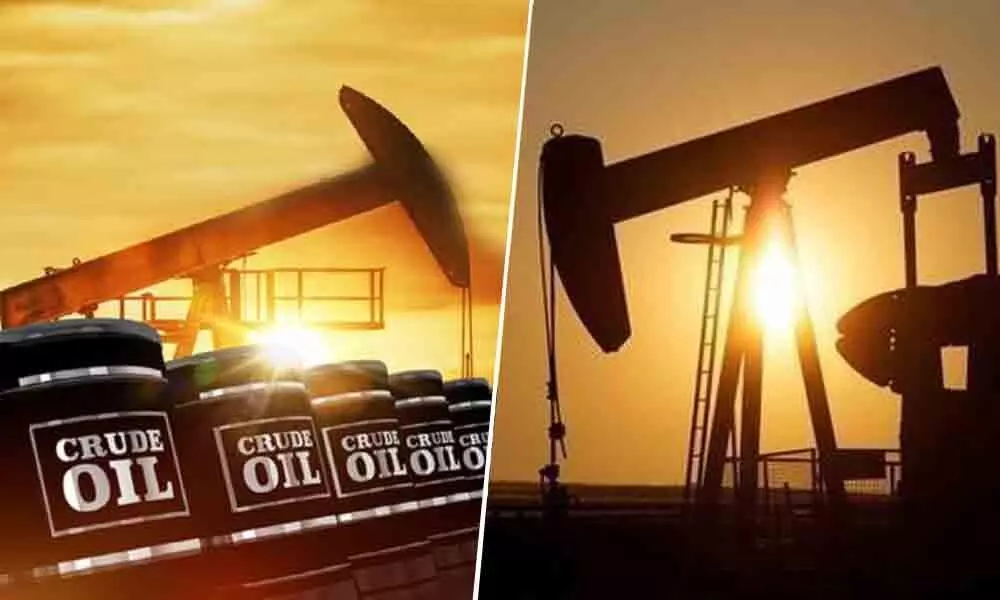Live
- Police book case against KTR for unauthorised rally
- Literature crucial in nurturing creativity
- Academicians debate on trends observed in 2024 General Elections
- Adah Sharma to perform Shiv Tandav stotram at the MahaKumbh mela
- Haryana Guv urges TG, AP CMs to implement NEP-2020
- Tail-end farmers should get irrigation water, says Uttam
- SpinSci to churn out 1K AI-based jobs in Telangana
- Kothapalli-Manoharabad rly line to be operationalised by 2027
- Industrial production at 6-mth high in Nov
- Traffic restrictions on heavy vehicles in Rachakonda
Just In

Recently, US Shale price was up as Louisiana Light and MARS US rallied around 21 per cent and 3 per cent respectively.
Recently, US Shale price was up as Louisiana Light and MARS US rallied around 21 per cent and 3 per cent respectively. Other oil majors including OPEC Basket, URALS, WTI Crude, and Brent Crude took a hit between 8 per cent and 13 per cent.
The Indian Basket of crude oil also fell by around 14 per cent. A similar trend was seen in natural gas as it paired a gain of more than 2 per cent before falling flat to the level of $1.721, or 1.5 per cent lower than its opening price.
The current downward trajectory of the oil market is due to multiple factors. Following close on heels of trade war and coronavirus outbreak, the crude oil market is witnessing its own price war as the global players are ramping up production.
What is happening exactly?
The oil market has been oversupplied since quite some time now. The OPEC grouping was able to curb it by limiting production. However, the outbreak of coronavirus has decreased the global demand and split the grouping.
A consensus could not be reached in March on production cuts and both OPEC and non-OPEC countries are insistent on ramping up respective production.
Much like trade war, an oil supply war has now been triggered - primarily between Russia and Saudi Arabia. Saudi-based Aramco is boosting production by 2 million barrels a day while the Russian state oil company, Rosneft PJSC, is planning to increase the output by 300,000 barrels a day from as soon as April 1. The geopolitical situations of countries like Libya might also force them to increase supply.
What are its affects?
These developments will further drag down the prices in an already oversupplied oil market. This is happening as the demand fades in the wake of coronavirus. What we are staring at is a complete meltdown of the oil market if relevant measures are not taken.
US Shale is already dipping with WTI and Brent trading below $30. The $2 trillion economic stimulus package by the US has given a ray of hope to the market, as some support could be seen today. However, this hope is as bleak as it can get. All oil producers will necessarily have to cut down production to prevent oil prices from nose-diving.
What are the takeaways for India?
India stands to gain within these dynamics. A 10 per cent fall in crude prices has a direct impact of 40 to 50 bps on CPI inflation. Also, every $10/bbl drop in crude price will save around $16.3 billion of foreign exchange. Our country had imported 4.48 million bpd of oil in 2019.
It has now decided to purchase crude worth Rs. 5,000 crore to stock up its strategic reserve. The move might completely fill the 5.33 MT of Inda's strategic petroleum, which was half-full before.
Lastly, lower fuel price also increase the net disposable income of consumers. So, low crude oil price is a much needed shot in the arm for India especially in the backdrop of the COVID-19 outbreak.
(The author is DVP Equity Strategist at Angel Broking Ltd. View expressed this article are his own)

© 2025 Hyderabad Media House Limited/The Hans India. All rights reserved. Powered by hocalwire.com







